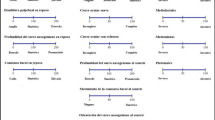Abstract
Patients with facial nerve palsy (FNP) are actually evaluated by other people rather than doctors or the patients themselves. This study was performed to investigate the characteristics of the perception of unilateral FNP in Korean people. A questionnaire using photographs of four patients with four different grades (House-Brackmann) of FNP was given to two hundred people with no FNP. Subjects of each gender, ranging from 20 to 69 years of age, participated. The questionnaire, showing facial expressions of resting, smiling, whistling, eye closing, and frowning, consisted of questions concerning the identification and the involved side of FNP, the unnatural areas of the face, and the unnaturalness of the facial expressions. The overall identification rate of FNP was 75.0 %. The identification rate increased according to the increase in the grade of the patient’s FNP (p < .001). The overall detection rate of the involved side was 54.5 %, and that rate decreased with increasing subject age (p < .001). The area of the most unnatural facial expression was reported to be the mouth, followed by the eyes and cheeks. The most unnatural facial expression was also reported to be smiling, followed by eye closing and whistling. There was no difference in the identification rate of FNP according to education level. However, the overall detection rate of the involved side was higher in the high-education group (p < .001). The detection rate for the involved side of FNP was lower than the rate of identification of FNP and was significantly low in the middle-aged/elderly and low-education level groups.




Similar content being viewed by others
References
Coulson SE, O’Dwyer NJ, Adams RD et al (2004) Expression of emotion and quality of life after facial nerve paralysis. Otol Neurotol 25:1014–1019
Ryzenman JM, Pensak ML, Tew JM Jr (2005) Facial paralysis and surgical rehabilitation: a quality of life analysis in a cohort of 1,595 patients after acoustic neuroma surgery. Otol Neurotol 26:516–521
House JW, Brackmann DE (1985) Facial nerve grading system. Otolaryngol Head Neck Surg 93:146–147
Kang TS, Vrabec JT, Giddings N, Terris DJ (2002) Facial nerve grading systems (1985–2002): beyond the House-Brackmann scale. Otol Neurotol 23:767–771
Murty GE, Diver JP, Kelly PJ et al (1994) The Nottingham System: objective assessment of facial nerve function in the clinic. Otolaryngol Head Neck Surg 110:156–161
Burres S, Fisch U (1986) The comparison of facial grading systems. Arch Otolaryngol Head Neck Surg 112:755–758
Ross BR, Fradet G, Nedzelski JM (1994) Development of a sensitive clinical facial grading system. Eur Arch Otorhinolaryngol S180–181
Hu WL, Ross B, Nedzelski J (2001) Reliability of the Sunnybrook Facial Grading System by novice users. J Otolaryngol 30:208–211
Bagger-Sjoback D, Remahl S, Ericsson M (2005) Long-term outcome of facial palsy in neuroborreliosis. Otol Neurotol 26:790–795
Ishii L, Godoy A, Encarnacion CO et al (2012) Not just another face in the crowd: society’s perceptions of facial paralysis. Laryngoscope 122:533–538
Ishii LE, Godoy A, Encarnacion CO et al (2011) What faces reveal: impaired affect display in facial paralysis. Laryngoscope 121:1138–1143
Fu L, Bundy C, Sadiq SA (2011) Psychological distress in people with disfigurement from facial palsy. Eye (Lond) 25:1322–1326
Bradbury E (1997) Understanding the Problems. Visibly different: coping with disfigurement. Butterworth-Heinemann, Oxford, p 180
Ikeda M, Nakazato H, Hiroshige K et al (2003) To what extent do evaluations of facial paralysis by physicians coincide with self-evaluations by patients: comparison of the Yanagihara method, the House-Brackmann method, and self-evaluation by patients. Otol Neurotol 24:334–338
Ishii L, Carey J, Byrne P et al (2009) Measuring attentional bias to peripheral facial deformities. Laryngoscope 119:459–465
Vickery LE, Latchford G, Hewison J et al (2003) The impact of head and neck cancer and facial disfigurement on the quality of life of patients and their partners. Head Neck 25:289–296
Kecskes G, Jori J, O’Reilly BF et al (2011) Clinical assessment of a new computerised objective method of measuring facial palsy. Clin Otolaryngol 36:313–319
Neely JG, Joaquin AH, Kohn LA et al (1996) Quantitative assessment of the variation within grades of facial paralysis. Laryngoscope 106:438–442
O’Reilly BF, Soraghan JJ, McGrenary S, He S (2010) Objective method of assessing and presenting the House-Brackmann and regional grades of facial palsy by production of a facogram. Otol Neurotol 31:486–491
Sargent EW, Fadhli OA, Cohen RS (1998) Measurement of facial movement with computer software. Arch Otolaryngol Head Neck Surg 124:313–318
Pourmomeny AA, Zadmehr H, Hossaini M (2011) Measurement of facial movements with Photoshop software during treatment of facial nerve palsy. J Res Med Sci 16:1313–1318
Sawai N, Hato N, Hakuba N et al (2012) Objective assessment of the severity of unilateral facial palsy using OKAO Vision VR facial image analysis software. Acta Otolaryngol 132:1013–1017
Baricich A, Cabrio C, Paggio R et al (2012) Peripheral facial nerve palsy: how effective is rehabilitation? Otol Neurotol 33:1118–1126
Keen MS, Burgoyne JD, Kay SL (1993) Surgical management of the paralyzed eyelid. Ear Nose Throat J 72(693):659–701
Yucel OE, Arturk N (2012) Botulinum toxin-A-induced protective ptosis in the treatment of lagophthalmos associated with facial paralysis. Ophthalmic Plast Reconstr 28:256–260
Sadiq SA, Khwaja S, Saeed SR (2012) Botulinum toxin to improve lower facial symmetry in facial nerve palsy. Eye (Lond) 26:1431–1436
Conflict of interest
None.
Author information
Authors and Affiliations
Corresponding author
Rights and permissions
About this article
Cite this article
Mun, S.J., Park, K.T., Kim, Y. et al. Characteristics of the perception for unilateral facial nerve palsy. Eur Arch Otorhinolaryngol 272, 3253–3259 (2015). https://doi.org/10.1007/s00405-014-3400-0
Received:
Accepted:
Published:
Issue Date:
DOI: https://doi.org/10.1007/s00405-014-3400-0




